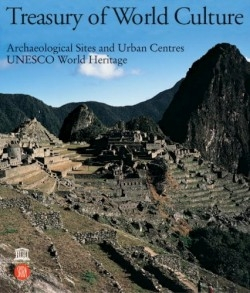Treasury of World Culture
Archaeological Sites and Urban Centers
At first glance, Xi’an, China, with its army of terracotta warriors, and Pisa, Italy, with its famously leaning tower, seem to have little in common. But they share one notable characteristic: both cities, along with three hundred and eighty-nine other significant locations, have been selected as a UNESCO World Heritage Site.
This first volume of the UNESCO Treasury of World Culture focuses on forty-six main “archaeological sites and urban centers,” and the agony of the compilers, on having to leave out so many other worthy sites, rapidly becomes clear. Establishing “canon” is always difficult; determining priority when the fate of crumbling archaeological sites seems to hang in the balance appears to be even more troubling. The choices were “difficult and made reluctantly, and even so required painful exclusions,” writes the publisher in the introduction.
In the end, the core sites were chosen to show “how the forma urbis has engaged humanity in the adaptation and radical transformation of the natural landscape.” Translated, this means that the imposing sacred complex that is Stonehenge, the charming island-city of Dubrovnik, and the bustling hive of Marrakesh all offer meaningful examples of how environment and culture have led men and women to create unique, perfectly adapted, often beautiful living spaces. Each site gets its own small section; the sections are grouped by continent. An appendix of the other three hundred and forty-five World Heritage sites is included.
Visually, the book is entrancing. The photographs of each site are a glorious invitation to travel to these places and learn more. Climb the pyramids at Chichen Itza, they urge. Wander the crumbling Forum of Rome. Explore India’s Caves of Ajanta and marvel at the frescoes.
Sometimes frustratingly, the text is a mere tease. With each site, the writers offer short, matter-of-fact histories and a single in-depth paragraph on a building, ruler or piece of art. Certainly, some intriguing little stories slip in: for example, the tale of Petra’s first European discoverer, a young Swiss explorer whose Bedouin guides led him astray with lies about Pharaohs founding monuments in Jordan.
However, in general, the discussions are brief. The section on Pompeii, referring to the event that froze the ancient city in time, states simply: “in August of A.D. 79, the terrible eruption of Mount Vesuvius entirely buried the city in a thick blanket of ash and fragments of volcanic debris, suffocating its flourishing life.”
As a result, fans of the more comic, romantic or dramatic sides of history may find themselves tantalized but not satiated. In fact, this Treasury of World Culture is a lovely, well-produced introduction, and an invitation to seek out more information for yourself—which may, after all, be the editors’ point.
Disclosure: This article is not an endorsement, but a review. The publisher of this book provided free copies of the book to have their book reviewed by a professional reviewer. No fee was paid by the publisher for this review. Foreword Reviews only recommends books that we love. Foreword Magazine, Inc. is disclosing this in accordance with the Federal Trade Commission’s 16 CFR, Part 255.

